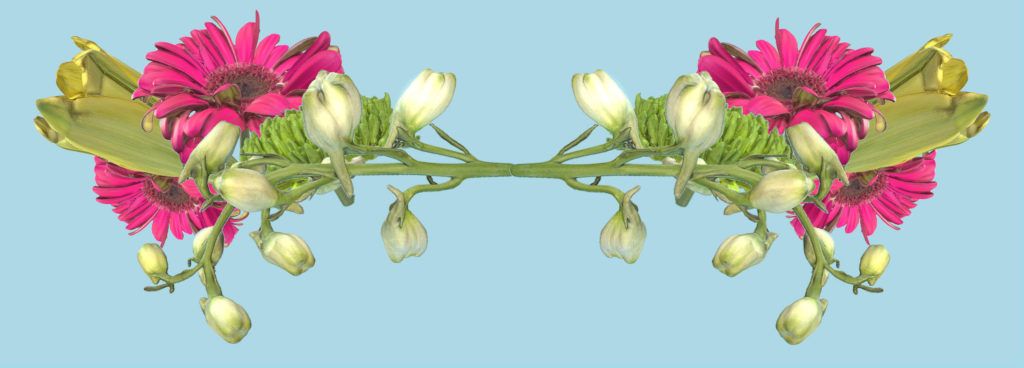
Creating artwork from 3D rendered still images
High-Definition Botanical 3D Scanning
Depending on where you live, in mid-May, spring might finally be here, or perhaps the summer heat is right around the corner. The birds are chirping, the flowers are blooming, and wedding bells are in the air. It also turns out that 3D scanning flowers is a budding new field thanks to advances in 3D scanning processing software from Artec 3D.
Artec Studio Version 14, 15, and 15.1 software released a bunch of new texture/color processing tools in addition to “HD Mode” that have dramatically increased the ability to scan formerly nearly impossible shapes to 3D scan, such as flowers and plants. Now is the best time to get into this new field of 3D scanning!
Read on to check out some great examples of how, why, and who benefits from botanical 3D scanning.
Botanical Research
Botany, the study and science of plant life, is a field with tremendous amounts of questions and limited ability to answer them. Biodiversity studies on shape, size, distribution, color, etc. of plants and their parts have long suffered from imprecise and/or slow hand measurements at best, to complete gaps in measurable data at worse. Plants tend to deform easily and using hand-measurement tools can deform them to the point of spoiling the repeatability of the measurements. Furthermore, even accessing the remote parts of the world where this kind of research needs to be done can be a major challenge, and a worst-case scenario would be to expend the cost and time of conducting field research only to leave with incomplete, missing, or incorrect measurements.
The Artec Space Spider 3D scanner is a botanist’s new best friend. High resolution, accurate, color-capable, this is the scanner to use for capturing the precise shape and structure for measurements. With a starting accuracy of about +/- 0.002” for small objects, the Artec Space Spider is the ideal scanner to bring into the field. Just make sure you bring a laptop or tablet along with the Artec portable battery pack!
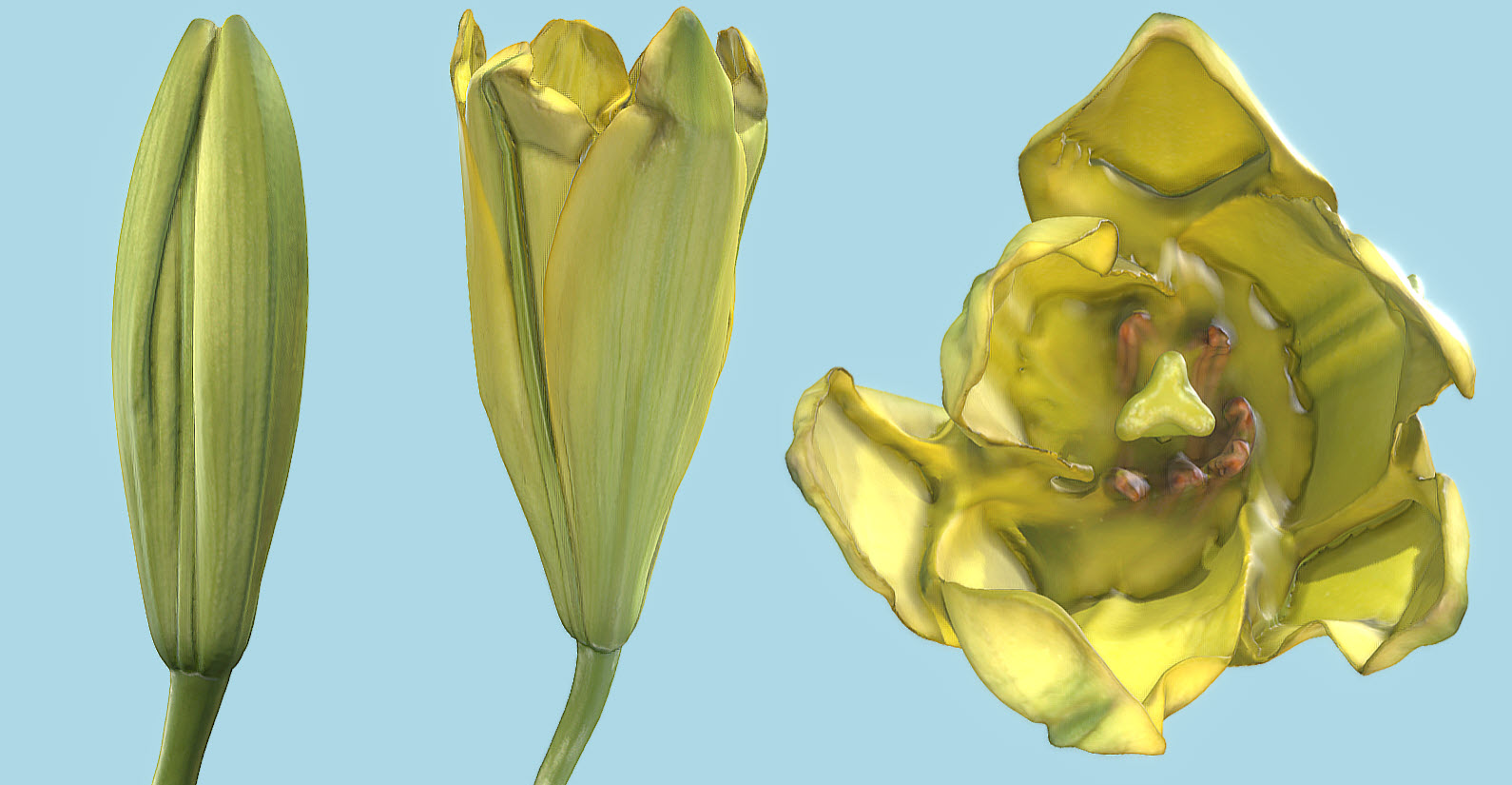
3D scans of a flower bud while closed and in the process of opening.
VR/AR and 3D Assets
You do not have to be a researcher to appreciate 3D scanning of plants and flowers. The fields of Augmented Reality (AR), Virtual Reality (VR), movies, TV, and video games are all prime candidates for using newly acquired 3D scan data of flowers and plants. Millions of dollars are spent annually on 3D-scan assisted virtual flythrough’s of houses, apartments, venues, etc. and this number should only increase as time goes on and the ability to fill those rooms with detailed 3D assets improves. While special long-range 3D scanners like the Artec Ray make short work of rooms and buildings, it is the job of a handheld 3D scanner like the Artec Leo, Artec Eva, or Artec Space Spider to “fill in the gaps” that these long-range scanners miss and to also capture individual items with high quality. The mix between “macro” long range scanning and “micro” handheld scanning can be merged together at last with the addition of direct 3D scans of plants and flowers without the need to pay a digital artist to manually recreate them from scratch.
3D Scanned with the Artec Space Spider 3D Scanner
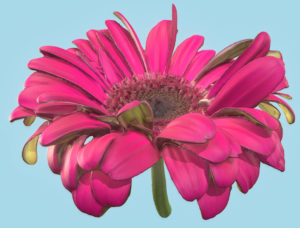 | |
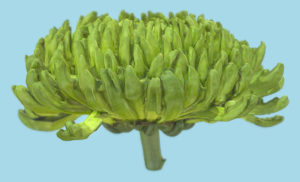 | |
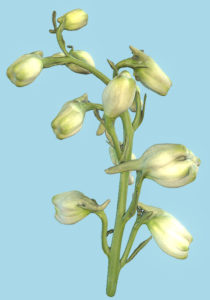 | |
Artec Studio’s 15.1 update introduced the “HD Mode” feature for the Artec Eva and Artec Leo 3D scanners, which allows formerly difficult-to-scan objects to be successfully 3D scanned. For example, a flower bouquet with individual petals and leaves and stems might have gaps in the data in standard mode, which can cause floating “islands” of data, but HD mode fills previously missing areas in with the proper shape. This reduces effort needed to post-process the data and speeds up the ability to end up with a high quality, color, 3D model.
How It’s Done
In previous posts we discussed topics such as how to fix movement in inanimate objects, and also living objects such as a person’s hand. Of course, Artec 3D scanners are best in the world at scanning living things and correcting for motion, however flowers and other bladed/petalled shapes are perhaps some of the most difficult objects to 3D scan and process. The reason for the difficulty lays in the objects’ interaction with the environment. A simple object like a coffee mug can be counted on to remain motionless during scanning, even on a turntable. The forces of gravity, inertia, or air resistance are not enough to interact with a mug enough to cause a problem fitting multiple sides of the mug’s scan data together. Flowers are a different story. The thin petals and blades are too lightweight to resist deforming under gravity or swaying due to air resistance. The slightest breeze midway through a scan of a flower is typically enough to change its shape to such a degree that a re-scan is necessary.
Fortunately, for most botanical research institutes out there, the Artec Space Spider requires only a modest amount of effort to setup in the field for 3D scanning flowers and other plants. Here is a list of critical considerations if you would like to 3D scan a flower while mitigating the chances for error:
- When scanning indoors, turn off or close all air vents and fans. Remember – “the slightest breeze” will cause flower petals to move. If in the field, scan inside a vehicle or a tent.
- Your body and torso sometimes act as a large sail, and if you move around too quickly or suddenly, you will cause air gusts that will end up moving the flower petals. Move very smoothly and glide through the air as gracefully as you can during scanning.
- Consider not using a turntable. Lazy Susan turntables tend to slightly wobble due to imperfections in the turntable mechanism, and automated turntables will suddenly start and stop where the force of inertia will cause the flower to wobble. Consider how “stiff” the flower is, and whether a turntable will cause the petals to move. Sometimes it will be OK, but other times, the turntable could be the singular cause of problems.
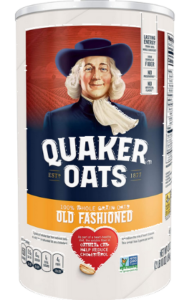
- Scan on a sturdy ground floor. Some floors in older buildings tend to shake if you walk around with heavy footsteps. So, avoid lumbering around during 3D scanning; try to maneuver gracefully with the stealth of a ninja, or a cat, or a ninja-cat.
- Avoid direct sunlight with the Artec Space Spider and the Artec Eva. Sunlight is OK for the Artec Leo.
- Use a richly colored platform/stage for flowers. Consider using something simple like a carton of oatmeal as a makeshift vase to hold the flowers in (trim the stems as needed). A tall 3D scanning stage like this allows you to easily lower the scanner below the flower and tilting upward to scan from a lower vantage point, and the rich color detail of the carton should be sufficient to allow for some level of human error in repositioning the scanner, as it can be tricky to scan from indirect angles that you are not personally watching.
Wrapping it Up
Artec 3D has dramatically increased their capabilities in 3D scanning small objects with high detail in recent years, and even challenging objects such as plants and flowers are well within the wheelhouse of Artec’s 3D scanners. Artec continues to innovate in new hardware and new software solutions and improvements, and the future of 3D scanning looks bright and colorful!
Do you have a project in mind that involves 3D scanning or want to know more about the Artec 3D Scanners? Contact us today to learn more about how Laser Design can help you incorporate 3D scanning into your design process.
View the full Laser Design Sketchfab page >
If you have the Sketchfab App, you can view our models in AR or VR on your mobile device.
Note: not all models are AR/VR ready.
View our Sample Files Library for more 3D files and examples.
Happy scanning!
